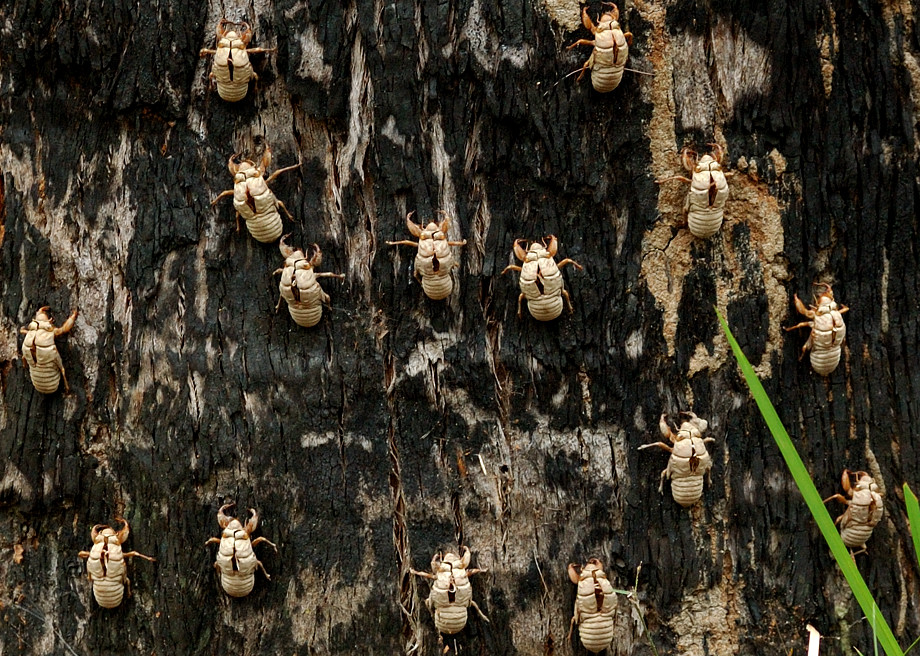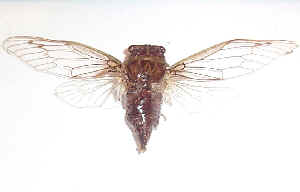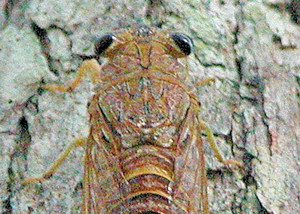|
| |
Family Cicadidae
- This page contains pictures and information about Cicadas in subfamily
Cicadinae that we found in the Brisbane area, Queensland, Australia.
-
 - Empty shells (called exuviae) are often seen on tree trunks on early
summer
-
- This subfamily includes mostly large cicada species. They are mostly
tree-dwelling species. They are usually brown and some are green in
colours.
-
Tribe Thophini
- Double Drummer
 
 - Thopha saccata, male, body length 45mm
Female
- Double Drummer Cicadas are the largest cicadas in Australia.
They make loudest sound in the insect world. They are brown in colour with black pattern.
For the males, on each side of the abdomen there are a small pockets, the
double drums, which are used to amplify the sound they produce. They
stay high on the tree and make the sound during the summer days. We have
details information about the cicada in this page.
-
-
- White Drummer Cicada
 - Arunta perulata, body length 40mm
- We found this cicada as dead body in Morton Island in mid summer 2001.
This cicada is dark brown in colour. Wings are clear, with two spots near the
tip on each forewing. The top edges of forewings are with green veins which
joints with a green line across the thorax. We failed to identify this
species as White Drummer Cicada because we expected two white drums. We
forgot female cicada does not have drums. Lindsay Popple
advised us by email that " it looks to be a worn female White Drummer Arunta
perulata, which is quite common in Banksias and Casuarinas in Morton Island."
Tribe Cyclochilini
- Razor Grinder
 
 - Henicopsaltria eydouxii, body length 40mm
- We found them in Mt Cotton during mid summer. They rested at the lower part
of the tall tree trunk, about 1.5 meters to 3 meters from ground. They produced very loud sound
resemble metal grinding. They are dark brown in colour with dark zigzag patterns on front wings
veins. The veins near wing edges are also dark in colour. For more pictures and
information please click on here.
-
-
- Black Friday


 - Psaltoda pictibasis, body length 30mm, male, female
- The cicada s are black in colour with brown pronotal collar. They prefer
the upper trunks and large stems of very large gumtrees. Please check this page
for more information.
-
-
- Black Prince

 -
- The common name Black Prince was loosely applied to almost any cicada
which were black in colour. Then it is now exclusively used for this species
Psaltoda plaga. Please check this page
for more details.
-
-
- Clanger, Clear Wing Cicada

  - Psaltoda claripennis, body length 25-30mm
- The cicada has the colour patterns of green on brown and dark brown. Its
eyes is pale red in colour. Its wings are clear with green vein. They are
common in Brisbane. We sometimes find them in
Wishart and
Karawatha Forest. More pictures and information can be found in here.
-
Tribe Cicadini
- Brown Bunyip
 
 - Tamasa tristigma, body length 20mm
- Brown Bunyip is one of the most commonly seen cicada in Brisbane. It is light brown in colour with black pattern on thorax. Across
the abdomen there are the black, brown and light brown narrow bands. Wings
are clear, males have three dark spots on tips of each forewings. They were found trees in our backyard in Eight mile Plains in Brisbane
during mid summer. They are small and usually rest on the tree trunks about
two meters from ground. Because they often sit in the shadow, together with their camouflaged
colour, they are not easily seen. Their song is a long continuous low pitch
zeep which may continue for minutes. For more information and pictures please
click on here.
-
- Reference:
- 1. Insects
of Australia, CSIRO, Division of Entomology, Melbourne University
Press, 2nd Edition 1991, pp 464.
- 2. The cicadas of central eastern Australia - L. W. Popple, Zoology and Entomology, the University of Queensland, Australia, 2006.
Back to Top
[ Up ] [ Cicada Biology ] [ Cicadinae ] [ Tibicininae ]
| |
|



















